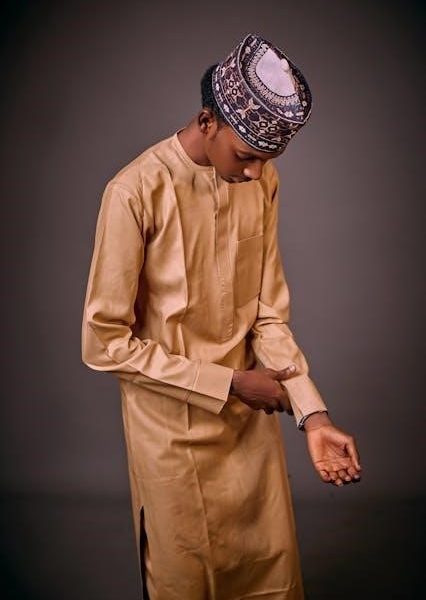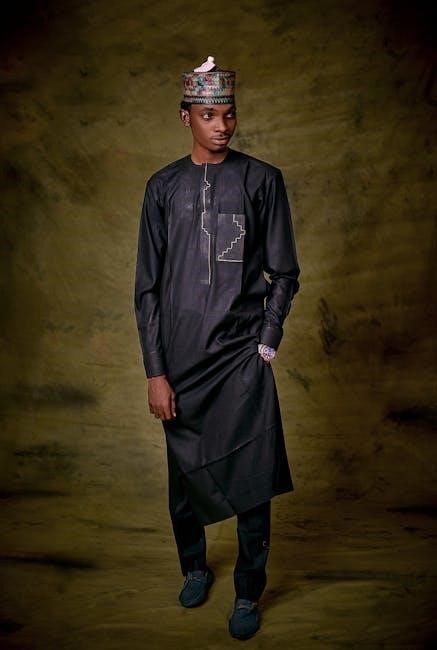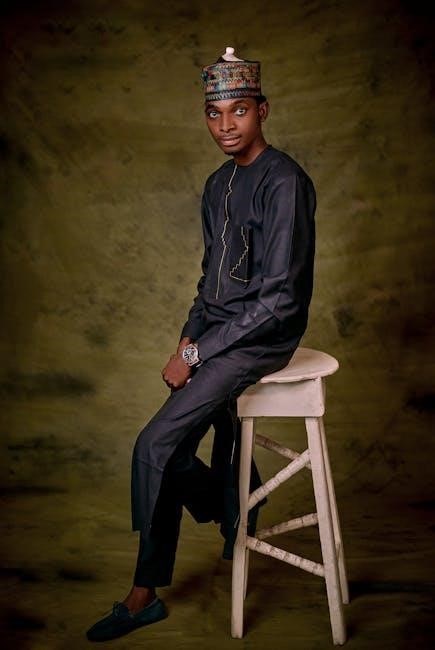
mens hat size guide
Understanding men’s hat sizes is crucial for both style and comfort․ A proper fit ensures a hat stays in place and complements the wearer’s overall appearance․ Hat sizing varies by country and material‚ with measurements typically based on head circumference․ This guide will explore the essentials of hat sizing‚ helping you make informed choices for the perfect fit․
1․1 What is a Hat Size?
A hat size is a standardized measurement used to determine the fit of a hat based on the circumference of the wearer’s head․ It is typically measured in inches or centimeters and varies slightly depending on the material and style of the hat․ Hat sizes can be numerical‚ such as 7 or 7 1/2‚ or labeled as small‚ medium‚ or large․ Proper sizing ensures comfort and prevents the hat from being too tight or too loose․ Understanding hat sizes is essential for selecting a hat that fits well and enhances the wearer’s appearance․ This guide provides a clear explanation of hat sizing to help you make informed choices․
1․2 Importance of Proper Fit
A proper-fitting hat is essential for both style and comfort․ A hat that is too tight can cause discomfort and even headaches‚ while one that is too loose may shift or blow off in the wind․ A well-fitted hat enhances the wearer’s appearance‚ creating a polished and put-together look․ It also ensures the hat functions as intended‚ whether for sun protection‚ warmth‚ or fashion․ Proper fit boosts confidence‚ allowing the wearer to enjoy the hat’s intended purpose without distractions․ Investing time in finding the right size ensures a seamless and enjoyable experience‚ making the hat a reliable and stylish accessory for any occasion․
1․3 Brief History of Hat Sizing
Hat sizing has evolved significantly over time‚ transitioning from manual fittings to standardized systems․ Historically‚ hats were tailored to individual head sizes‚ often requiring multiple measurements․ In the late 19th century‚ hatmakers began developing sizing scales‚ with Britain using imperial measurements and the U․S․ creating its own system․ The introduction of factory-produced hats in the early 20th century necessitated standardized sizes for mass production․ Today‚ hat sizing is based on head circumference‚ with precise charts ensuring a universal fit․ This evolution reflects the balance between craftsmanship and practicality‚ making hat sizing accessible to a global audience while maintaining quality and comfort․

How to Measure Your Head for a Hat
Measure your head circumference with a tape measure‚ about 1 cm above your eyebrows and ears․ Ensure the tape is level for an accurate fit․
2․1 Tools Needed for Measurement
To measure your head accurately‚ you’ll need a flexible tape measure or a string long enough to wrap around your head․ A ruler and a mirror can also be helpful․ Place the tape measure or string about 1 cm above your eyebrows and ears‚ ensuring it’s level and not too tight or loose․ If using a string‚ mark the point where it overlaps and measure the length with a ruler․ This method ensures precision and helps determine your hat size effectively․ Having a mirror can assist in maintaining the correct positioning of the tape measure for an accurate fit․
2․2 Step-by-Step Measurement Guide
Start by placing the tape measure or string around your head‚ positioning it approximately 1 cm above your eyebrows and ears․ Ensure the tape is level and not tilted․ Gently tighten the tape until it feels snug but not restrictive․ If using a string‚ mark the point where it intersects and measure the length with a ruler․ Record the measurement in inches to determine your hat size․ For accuracy‚ take the measurement twice and average the results․ This method ensures a precise fit‚ whether you’re shopping for a fedora‚ baseball cap‚ or any other style․ Proper alignment is key for an accurate reading․
2․3 Tips for Accurate Measurement
For precise hat sizing‚ ensure the tape measure is level and not angled․ Measure about 1 cm above your eyebrows and ears‚ keeping the tape snug but not overly tight․ Avoid measuring too loosely‚ as this can lead to an oversized fit․ Use a flexible tape measure or string for the best results․ If using a string‚ mark the intersection point and measure it with a ruler․ Take the measurement multiple times to ensure consistency‚ and consider having someone assist for accuracy․ Proper alignment and a relaxed posture will yield the most reliable results‚ ensuring your hat fits comfortably and looks its best․

Men’s Hat Size Charts
Men’s hat size charts provide standardized measurements to ensure the perfect fit․ Sizes typically range from 6 1/2 to 8‚ based on head circumference in inches․ Use a tape measure to determine your size‚ ensuring accuracy for optimal comfort and style․ These charts are essential for selecting hats that complement your head shape and personal preferences‚ guaranteeing a flattering and comfortable fit every time․
3․1 Standard Hat Size Chart
A standard hat size chart is based on head circumference‚ measured in inches․ Sizes typically range from 6 1/2 (20 inches) to 8 (24 inches)․ Each size represents a specific circumference‚ ensuring a precise fit․ To determine your size‚ measure around your head about 1 inch above your eyebrows and ears․ For example‚ a 7 1/8 size corresponds to a 21 1/4-inch circumference․ This chart is widely used across hat styles‚ from fedoras to baseball caps‚ ensuring consistency․ Accurate measurements are key to finding the perfect fit‚ as ill-fitting hats can be uncomfortable or unflattering․ Always refer to the chart for reliable sizing guidance․
3․2 Hat Sizes by Country
Hat sizes vary by country‚ with different systems used globally․ In the U․S․‚ hat sizes are based on head circumference in inches‚ ranging from 6 1/2 to 8․ The British system also uses inches but labels sizes differently‚ such as 6 3/4 or 7 1/8․ European sizes often use centimeters‚ with measurements rounded to the nearest half centimeter․ Japanese hat sizes also use centimeters but may have smaller ranges․ Understanding these differences is crucial when shopping internationally or comparing sizes across brands․ Always check the specific sizing chart for the country or brand to ensure accuracy and avoid discrepancies in fit․
3․3 Converting Measurements to Hat Sizes
Converting head measurements to hat sizes involves understanding the specific sizing systems used․ Measure your head circumference using a tape measure‚ typically placed about 1 inch above your eyebrows and ears․ Once you have your measurement in inches‚ refer to a hat size chart to find the corresponding size․ For example‚ a 22-23 inch circumference usually equates to a size 7 1/8․ International charts may vary slightly‚ so always check the regional sizing guide․ Accurate conversion ensures a proper fit‚ whether shopping domestically or internationally․ This step is crucial for selecting a hat that complements both style and comfort effectively․

Factors Influencing Hat Fit
Head shape‚ material stretch‚ and seasonal variations impact hat fit․ Proper sizing ensures comfort and style‚ making it essential to consider these factors for the best result․
4․1 Head Shape and Hat Fit
Head shape significantly influences hat fit‚ as different shapes require specific styles for optimal comfort and aesthetics․ Oval heads‚ the most common shape‚ suit various hat styles due to their balanced proportions․ Round heads benefit from hats with angular or tall crowns to elongate the silhouette‚ while elongated heads look best with wide-brimmed hats to balance length․ Understanding your head shape helps in selecting hats that complement your features‚ ensuring both comfort and a flattering appearance․ Measuring your head and trying on hats can help determine the most suitable styles for your unique shape․
4․2 Seasonal Hats and Fit
Seasonal hats are tailored to specific weather conditions‚ ensuring comfort and functionality․ Summer hats‚ often made from lightweight materials like straw or canvas‚ feature breathable designs to keep heads cool․ Winter hats‚ crafted from wool‚ fleece‚ or fur‚ provide insulation and warmth․ The fit of seasonal hats may vary slightly due to additional features like earflaps or brims․ Proper sizing ensures optimal performance‚ whether shielding from sun glare or retaining heat․ Balancing style with practicality‚ seasonal hats adapt to environmental needs while maintaining a tailored fit for all-year-round wear․
4․3 Hat Materials and Stretch
Different hat materials significantly influence fit and stretch․ Wool and felt hats offer moderate stretch‚ providing a snug fit while allowing slight flexibility․ Straw hats are more rigid‚ maintaining their shape without stretching‚ ideal for summer wear․ Panama hats‚ known for their lightweight weave‚ offer a bit of stretch for comfort․ Understanding material properties helps in choosing hats that fit well and meet seasonal needs․ Proper fit ensures comfort and functionality‚ whether it’s a warm wool hat for winter or a breathable straw hat for summer․ Selecting the right material ensures your hat stays comfortable and in place all day long‚ enhancing your overall satisfaction with the fit․

Popular Men’s Hat Styles
From classic fedoras to sporty baseball caps‚ Panama hats‚ and rugged cowboy hats‚ each style offers unique appeal․ These timeless designs cater to diverse tastes and preferences‚ ensuring there’s a perfect hat for every man․
- Fedora: A sophisticated choice with an indented crown․
- Baseball Cap: A sporty‚ casual option for everyday wear․
- Panama Hat: Lightweight and elegant‚ ideal for summer․
- Cowboy Hat: A bold‚ classic style with western charm․
- Beanie: A versatile‚ warm option for colder climates․
5․1 Fedora

The fedora is a classic soft felt hat with an indented crown‚ typically 4-6 inches tall‚ and a wide brim of 2-4 inches․ Its soft brim allows for easy shaping‚ making it versatile for various styles․ Originally designed for functionality‚ the fedora has evolved into a fashionable accessory‚ suitable for both formal and casual occasions․ It is often made from felt or straw‚ with indented crowns and decorative bands adding elegance․ The fedora complements most face shapes and can be dressed up or down‚ making it a timeless choice for men seeking sophistication and comfort․ Its versatility ensures it remains a popular option for many wardrobes․
5․2 Baseball Cap
The baseball cap is a casual and versatile hat style‚ typically made from canvas‚ cotton‚ or polyester․ It features a curved brim that shields the eyes from sunlight and a button on top for a sporty look․ The adjustable strap at the back ensures a customizable fit‚ making it suitable for various head sizes․ Originally designed for athletes‚ the baseball cap has become a fashion staple‚ often featuring logos or embroidery․ It is ideal for informal settings and can be paired with streetwear or everyday outfits․ The baseball cap is a practical and stylish choice‚ offering both functionality and a modern aesthetic for men of all ages and face shapes․
5․3 Panama Hat
The Panama hat is a lightweight‚ breathable hat made from Toquilla straw‚ originating in Ecuador․ Known for its woven design‚ it offers excellent sun protection with a wide brim․ Its lightweight nature makes it ideal for summer and tropical climates․ Panama hats are versatile‚ suitable for both casual and formal events‚ and can complement a variety of outfits․ They are often associated with classic elegance and are a popular choice for outdoor activities․ Despite its name‚ the Panama hat is not made in Panama but is deeply rooted in Ecuadorian craftsmanship․ Its timeless appeal and practicality make it a favorite among men seeking style and functionality․

How to Choose the Right Hat
Choosing the right hat involves considering face shape‚ personal style‚ and occasion․ A well-chosen hat enhances your look and ensures comfort‚ making it a perfect accessory for any setting․
6․1 Considering Face Shape
When choosing a hat‚ your face shape plays a significant role in selecting a flattering style․ For oval-shaped faces‚ most hat styles work well due to their balanced proportions․ Round faces benefit from angular or asymmetrical hats to create length‚ while square faces are softened by curved or rounded styles․ Heart-shaped faces look best with hats featuring wide brims to balance the forehead․ Understanding your face shape helps narrow down hat styles that complement your features‚ ensuring a harmonious and stylish look․ This step is crucial for making a hat a flattering addition to your wardrobe․
6․2 Matching Personal Style
Choosing a hat that aligns with your personal style ensures it becomes a seamless part of your wardrobe․ Consider your fashion aesthetic—casual‚ formal‚ or vintage—and select a hat that complements it․ For example‚ a fedora suits a sophisticated look‚ while a baseball cap fits casual outfits․ Lifestyle also matters; outdoor enthusiasts might prefer durable materials like canvas‚ whereas formal events call for finer fabrics like wool or silk․ Personality plays a role too‚ as bold styles like panamas can reflect confidence․ Aligning your hat with your style ensures it enhances your look and reflects your individuality‚ creating a cohesive and authentic appearance․
6․3Choosing Based on Occasion
6․3 Choosing Based on Occasion
The occasion greatly influences the choice of hat‚ as different events call for specific styles․ Formal gatherings‚ like weddings or business meetings‚ demand elegant hats such as fedoras or derbies‚ which exude sophistication․ Casual outings‚ such as picnics or sporting events‚ are perfect for relaxed styles like baseball caps or beanies․ Outdoor activities may require functional hats‚ such as panamas for sun protection or fur hats for cold weather․ Seasonal events‚ like summer festivals or winter holidays‚ also dictate appropriate choices․ Selecting a hat that matches the occasion ensures it complements the setting and enhances your overall look‚ making it a practical and stylish addition to your outfit․

Care Tips for Maintaining Hat Fit
Proper care ensures your hat retains its shape and fit․ Clean hats with soft brushes‚ avoid harsh chemicals‚ and store them in breathable boxes․ Reshape damp hats gently while drying to maintain their form and longevity․

7․1 Cleaning and Storage
Proper cleaning and storage are essential to maintain your hat’s fit and longevity․ For cleaning‚ use a soft-bristled brush to gently remove dirt and dust․ Avoid harsh chemicals or excessive water‚ as they can damage materials․ For storage‚ place your hat in a breathable box or bag to prevent moisture buildup․ Avoid folding or compressing hats‚ especially those made of felt or straw‚ as this can cause permanent damage․ Reshape damp hats by placing them on a clean‚ dry surface to air out․ Store hats away from direct sunlight to prevent fading․ Regular maintenance ensures your hat remains well-fitted and stylish for years․
7․2 Reshaping and Maintenance
Reshaping and maintaining your hat ensures it retains its form and fit over time․ For felt hats‚ gently steam the area to reshape it‚ then allow it to cool․ Avoid using heat on straw hats‚ as it can cause warping․ Use a hat jack or stuff the crown with tissue paper to maintain shape when not in use․ For minor dents‚ lightly press with your fingers or a soft cloth․ Regularly brushing your hat helps remove dust and prevent damage․ Store it in a cool‚ dry place to avoid deformation․ Proper reshaping and maintenance will extend the life of your hat and keep it looking its best․
8․1 Final Thoughts on Hat Sizing
Mastering men’s hat sizing is key to both style and comfort․ A well-fitting hat enhances confidence and complements your appearance; Remember‚ proper sizing ensures functionality and aesthetics․ Always measure accurately‚ consider head shape‚ and choose materials that suit your needs․ Seasonal styles and personal preferences should guide your selections․ Regular care and maintenance ensure longevity․ With this guide‚ you’re equipped to find the perfect hat․ Experiment with styles‚ embrace your uniqueness‚ and enjoy the timeless appeal of a well-chosen hat․ Confidence and comfort are just a measurement away—happy hat shopping!

Additional Resources
Explore more guides on hat sizing at Helen Kaminski and Fashionable Hats․ Discover detailed charts and styling tips for a perfect fit․
9․1 Further Reading
For deeper insights‚ explore resources like Helen Kaminski’s Size & Fit Guide and Fashionable Hats’ detailed sizing charts․ These provide expert advice on measuring head circumference‚ understanding material stretch‚ and navigating global size variations․ Additional articles on hat styling and historical sizing methods offer a comprehensive understanding․ Knitting patterns and designer tips also share practical knowledge for crafting or choosing the perfect hat․ These resources ensure a well-rounded understanding of men’s hat sizing and fit․
Related posts:
Archives
Calendar
| M | T | W | T | F | S | S |
|---|---|---|---|---|---|---|
| 1 | 2 | |||||
| 3 | 4 | 5 | 6 | 7 | 8 | 9 |
| 10 | 11 | 12 | 13 | 14 | 15 | 16 |
| 17 | 18 | 19 | 20 | 21 | 22 | 23 |
| 24 | 25 | 26 | 27 | 28 | 29 | 30 |
Leave a Reply
You must be logged in to post a comment.